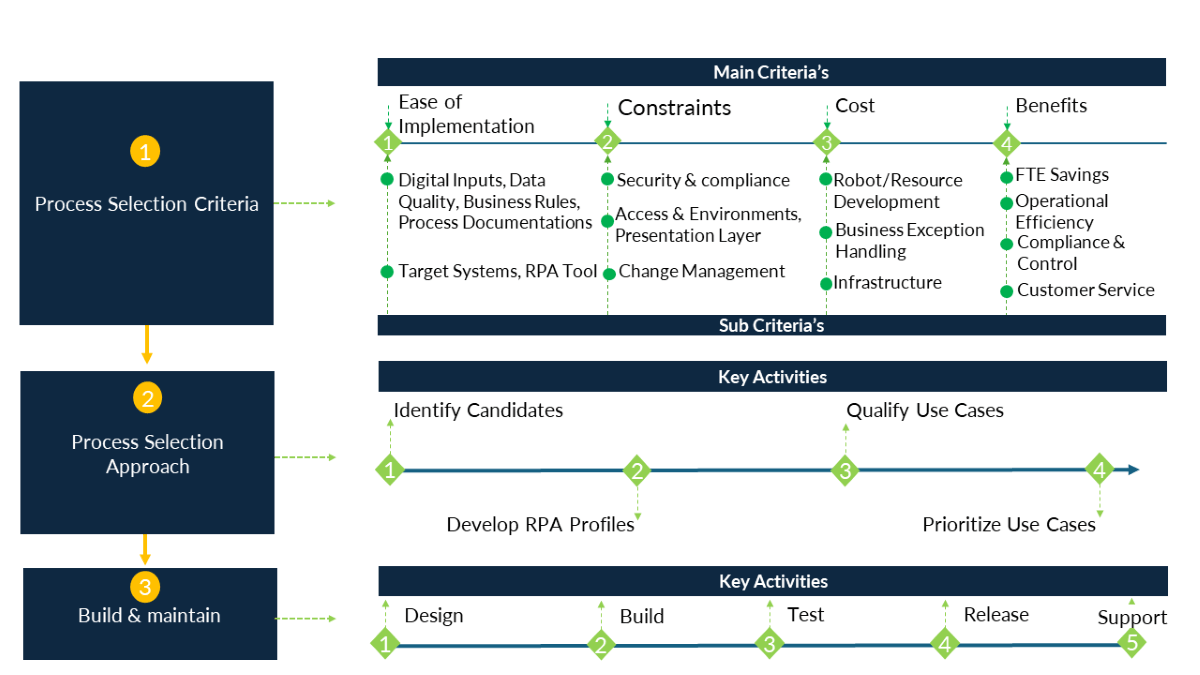
Background
The client is among North America’s leading healthcare providers, offering primary, virtual, and urgent care to patients. They have nearly 200 medical centers across the country. Their experienced, compassionate care teams provide same-day care to help their patients feel healthy every day of the year.
Problem Statement
The healthcare provider is exploring ways to improve operational efficiency and reduce costs by integrating automation technologies into their processes, aligning with their business goals.
Framework

Solution
Understanding Processes from Documents, Interviews, and Discussions and Building Process Maps
Navikenz initiated the optimization process by thoroughly analyzing existing documents, conducting comprehensive interviews with key stakeholders, and engaging in detailed discussions to gain insights into current processes. Utilizing the information gathered, Navikenz constructed detailed process maps that visually depict workflow structures, dependencies, and pain points.
Reviewing Current State Process Flow and Identifying, Listing, Prioritizing, and Finalizing Opportunities for Improvement
A critical examination of the current state process flow was conducted to identify inefficiencies and areas ripe for improvement. Through meticulous analysis, Navikenz compiled a comprehensive list of improvement opportunities, prioritizing initiatives based on factors such as potential impact, feasibility, and alignment with organizational goals. Following a thorough evaluation, Navikenz finalized a strategic plan to address identified opportunities.
Conducting Time Study of Processes and Building a Business Case around Them
Navikenz conducted detailed time studies of processes identified for improvement, capturing key metrics related to process duration, resource utilization, and efficiency. Based on the findings, Navikenz constructed a robust business case that outlined the anticipated benefits of optimization initiatives, including enhanced productivity, reduced operational costs, and improved quality of service.
Developing an Impact Analysis by Estimating the Time Saved
An impact analysis was conducted to quantify the benefits associated with process improvements. By estimating the time saved through optimization initiatives, Navikenz provided stakeholders with valuable insights into potential efficiency gains and operational enhancements. This analysis served as a critical tool for informed decision-making and prioritization of improvement efforts.
Converting Time Savings into Cost Savings by Calculations
Navikenz translated the time savings identified through process optimization into tangible cost savings through rigorous calculations. By quantifying the value of time saved in terms of labor costs, resource utilization, and operational efficiencies, Navikenz provided stakeholders with a clear understanding of the financial implications of improvement initiatives. This process reinforced the business case for change and underscored the tangible benefits of optimizing operational workflows.
Results
Implementation finalized automation opportunities reduced the process time by half, leading to significant cost savings of more than $200,000 for the healthcare provider operations.
Conclusion
The successful integration of automation opportunities has proven to be a transformative endeavor for the healthcare provider's operations. By reducing the process time by half and achieving significant cost savings of more than $200,000, the organization has realized substantial efficiencies and financial benefits. This case study underscores the immense value of proactive process optimization and the impactful outcomes that can be achieved through the strategic implementation of automation initiatives. Moving forward, the healthcare provider is poised to continue leveraging technology and innovation to drive operational excellence and deliver enhanced value to stakeholders and patients alike.
